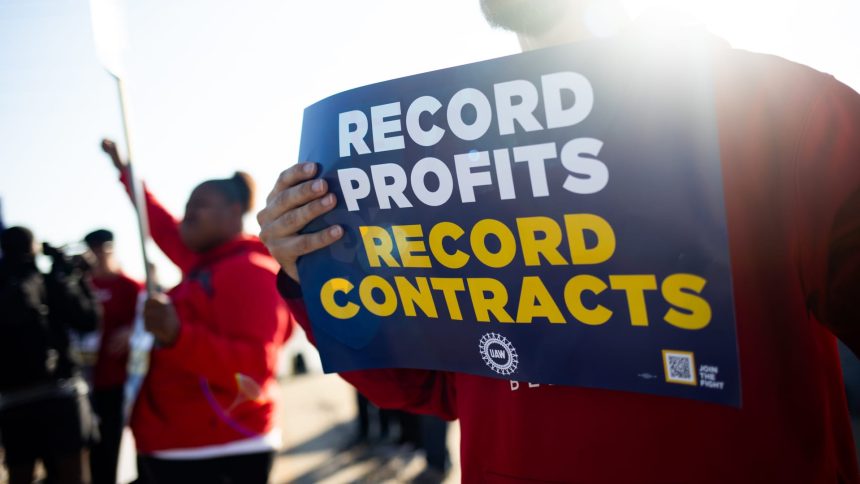The United Auto Workers targeted all three Detroit automakers — General Motors (GM), Chrysler-owner Stellantis (STLA) and Club name Ford (F) — with walkouts for the first time in its history. But the strikes by less than 13,000 UAW members at three plants, one at each company, are much more contained than many had feared. Shares of all three automakers were actually higher in Friday’s session despite the market’s broader sell-off. Prior to the UAW walkouts going into effect, Ford and GM offered up a 20% pay increase, and Stellantis offered up a 17.5% increase. Unfortunately, that was not enough to avert the strikes. Both sides had been working on a deadline of 11:59 p.m. Thursday to reach a new labor agreement. That was when the old one was expiring. The union actions — and their ripple effects — have shut down 15% of America’s total auto production. No matter which side “wins,” the path ahead has much greater implications than simply the power dynamics within the auto industry. Here’s what is at stake While the partial strike of the Big Three may be seen as a good-faith attempt to mitigate the damage and ultimately reach a labor agreement, it’s certainly strategic on the part of the UAW. With a limited strike fund, these targeted work stoppages serve to prolong the union’s ability to stay out to keep the pressure on the automakers while paying its members. Based on commentary from Ford CEO Jim Farley, we see no scenario in which the union gets everything it’s asking for — not because the workers don’t deserve more money or because management cares only about shareholders. It’s because from what we’re hearing, it’s financially not feasible. Speaking with CNBC late Thursday, Farley quantified the union ask, saying employees would be getting $300,000 per year for a four-day work week. Had this type of compensation structure been in place over the past 10 years, Farley said Ford would have “lost $15 billion and gone bankrupt by now.” President Joe Biden on Friday expressed his support for the UAW , saying union workers have not been sharing fairly in the profits being made by the automakers. “Record corporate profits” should be shared with workers, Biden said, adding he hopes that both sides can get back to the bargaining table to reach what he called a win-win agreement. As we head into an election year, the president needs the economy to sustain and the auto industry is responsible for roughly 3% of U.S. gross domestic product. At the same time, Biden has continuously toted himself as the “most pro-union president” ever. He’s probably feeling the pressure after signing a bill in December 2022 to block a national U.S. railroad strike for fear of what that would mean for the U.S. economy. Double-edged sword Whether this approach works or broadens out to factories that have a greater impact on the bottom lines of the companies remains to be seen. However, the strike speaks to a greater trend we’ve seen in recent years as union efforts have picked up — no doubt in part a result of multi-decade high inflation rates and declining affordability. We do now that everyone, from those on the auto factory floor to those in the C-Suite — and across every industry — is watching this very closely to see who is declared the winner. Should the union be viewed as victorious it would embolden others to initiate or push forward with unionization efforts. Should it prove futile or end up hurting more workers than it helps, it may cause union organizers to proceed with caution and shift power back to employers. Either way, we think this ongoing negotiation serves to catalyze automation efforts as company leaders seek to mitigate the potential for additional employee-prompted disruptions in the future. Additionally, the more companies pay for labor the greater the incentive to invest in automation efforts as robots and automated factories require only the upfront investment and ongoing maintenance costs. There’s no need for vacation time, health benefits or sick leave, and they can run pretty much 24 hours a day, seven days a week, 365 days a year. That’s the fear of every American worker: machines taking away jobs. That’s also a reason UAW members are pushing to get as much money as they can now. It’s a double-edged sword playing out in real-time: secure higher pay with the understanding that it may mean a shorter timeframe to automation, which is on the horizon anyway. We aren’t saying it’s right, and we aren’t saying we’re happy about that possible future, but with the progress seen in artificial intelligence over the last year and the various use cases being tested by companies in every industry in regard to generative AI, it’s a dynamic that’s here to stay. (Jim Cramer’s Charitable Trust is long F. See here for a full list of the stocks.) As a subscriber to the CNBC Investing Club with Jim Cramer, you will receive a trade alert before Jim makes a trade. Jim waits 45 minutes after sending a trade alert before buying or selling a stock in his charitable trust’s portfolio. If Jim has talked about a stock on CNBC TV, he waits 72 hours after issuing the trade alert before executing the trade. THE ABOVE INVESTING CLUB INFORMATION IS SUBJECT TO OUR TERMS AND CONDITIONS AND PRIVACY POLICY , TOGETHER WITH OUR DISCLAIMER . NO FIDUCIARY OBLIGATION OR DUTY EXISTS, OR IS CREATED, BY VIRTUE OF YOUR RECEIPT OF ANY INFORMATION PROVIDED IN CONNECTION WITH THE INVESTING CLUB. NO SPECIFIC OUTCOME OR PROFIT IS GUARANTEED.
The United Auto Workers targeted all three Detroit automakers — General Motors (GM), Chrysler-owner Stellantis (STLA) and Club name Ford (F) — with walkouts for the first time in its history. But the strikes by less than 13,000 UAW members at three plants, one at each company, are much more contained than many had feared.
Read the full article here
News Room




